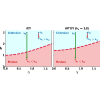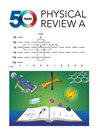通过非赫米提系统的动力学检测异常点
IF 2.9
2区 物理与天体物理
Q2 Physics and Astronomy
引用次数: 0
摘要
非赫米提旋转-时间反转(RT)-对称自旋模型具有两个截然不同的阶段,即整个谱都是实数的未断裂阶段和包含复数特征谱的断裂阶段,从而表明了一个过渡点,即例外点。我们报告说,动态量,即洛希米特回波的短期和长期平均值(即初始状态和最终状态之间的重叠),以及相应的速率函数,可以忠实地预测例外点。特别是,当初始态被准备为非赫米提哈密顿的未破裂相的基态,系统被淬火到破裂相或未破裂相时,我们通过分析证明,对于具有均匀磁场和交变磁场的近邻非赫米提 XY 模型,速率函数和洛什米特回波平均值可以区分发生在破裂相或未破裂相的淬火,从而指示出异常点。此外,我们还证明,即使是像有磁场的非ermitian 短程和长程 XYZ 模型这样只能通过数值求解的模型,这些量也能识别异常点,从而将其确立为识别异常点的检测标准。本文章由计算机程序翻译,如有差异,请以英文原文为准。

Detecting exceptional points through dynamics in non-Hermitian systems
Non-Hermitian rotation-time reversal -symmetric spin models possess two distinct phases, the unbroken phase in which the entire spectrum is real and the broken phase which contains complex eigenspectra, thereby indicating a transition point, referred to as an exceptional point. We report that the dynamical quantities, namely, the short- and long-time average of the Loschmidt echo, which is the overlap between the initial and the final states, and the corresponding rate function can faithfully predict the exceptional point. In particular, when the initial state is prepared as the ground state in the unbroken phase of the non-Hermitian Hamiltonian and the system is quenched to either the broken or unbroken phase, we analytically demonstrate that the rate function and the average Loschmidt echo can distinguish between the quench that occurred in the broken or the unbroken phase for the nearest-neighbor non-Hermitian model with uniform and alternating magnetic fields, thereby indicating the exceptional point. Furthermore, we exhibit that such quantities are capable of identifying the exceptional point even in models like the non-Hermitian short- and long-range model with magnetic field, which can only be solved numerically, thereby establishing it as detection criteria for recognizing exceptional points.
求助全文
通过发布文献求助,成功后即可免费获取论文全文。
去求助
来源期刊

Physical Review A
物理-光学
CiteScore
5.40
自引率
24.10%
发文量
0
审稿时长
2.2 months
期刊介绍:
Physical Review A (PRA) publishes important developments in the rapidly evolving areas of atomic, molecular, and optical (AMO) physics, quantum information, and related fundamental concepts.
PRA covers atomic, molecular, and optical physics, foundations of quantum mechanics, and quantum information, including:
-Fundamental concepts
-Quantum information
-Atomic and molecular structure and dynamics; high-precision measurement
-Atomic and molecular collisions and interactions
-Atomic and molecular processes in external fields, including interactions with strong fields and short pulses
-Matter waves and collective properties of cold atoms and molecules
-Quantum optics, physics of lasers, nonlinear optics, and classical optics
 求助内容:
求助内容: 应助结果提醒方式:
应助结果提醒方式:


